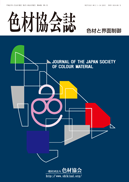All issues

Predecessor
Volume 88, Issue 3
Displaying 1-6 of 6 articles from this issue
- |<
- <
- 1
- >
- >|
Special Edition Current Topics for Titanium Dioxide
-
Koji TAKAHASHI2015 Volume 88 Issue 3 Pages 61
Published: March 20, 2015
Released on J-STAGE: June 20, 2015
JOURNAL FREE ACCESSDownload PDF (315K)
Review
-
-Photoconductivity of Mesoscopic Titanium Dioxide Electrodes and Molecular-Structured Solar Cells -Kazuhiro MANSEKI, Shozo YANAGIDA2015 Volume 88 Issue 3 Pages 62-66
Published: March 20, 2015
Released on J-STAGE: June 20, 2015
JOURNAL FREE ACCESSWe present here excellent photoconducting properties of mesoscopic nano-crystalline TiO2 (nc-TiO2) electrodes in dye-sensitized solar cells (DSSC). In addition, we demonstrate that Z907-sensitized nc-TiO2 solar cells consisting of emeraldine-type phenyl-capped aniline tetramer (EPAT) and tert-butylpyridine (TBP) as non-corrosive electrolytes shows a marked light-to-electricity conversion efficiency. DFT-based molecular orbital calculations suggest that EPAT undergoes in-situ self-organization in the electrolytes. Most importantly, the dimer of hydrogen bonding EPAT species, i.e., (EPAT-H-TBP)2, in nc-TiO2 electrodes contributes to unidirectional efficient electron transport in Z907/EPAT/TBP-based molecular-structured solar cells.View full abstractDownload PDF (1689K) -
Kaoru ISOBE2015 Volume 88 Issue 3 Pages 67-72
Published: March 20, 2015
Released on J-STAGE: June 20, 2015
JOURNAL FREE ACCESSThe biggest usage of titanium dioxide is white pigment being used in a wide variety of applications in our daily life such as paint, ink, plastic, paper, rubber, a chemical fiber and cosmetics. Main properties of pigments are dominantly determined by their chemical structure and crystalline form. However, even with an identical chemical structure, the optical properties and the behavior as a filler in a resin matrix can be different by controlling their particle size, shape, and surface properties. The functions of a pigment are not only coloring a paint, but also affecting characteristics of the paint by utilizing control technology of particle morphology and its surface property. In fact, there are several practical examples in which an inorganic pigment is not used for a coloring application but used especially as a functional material. In this study, the development of titanium dioxide as a functional material was generally explained from the viewpoint of such particle control and surface treatment.View full abstractDownload PDF (2501K)
Digest
-
Koichi YAMAGUCHI, Michiko ITO, Seigo TAKASHIMA, Masato OKA, Hiroyuki A ...2015 Volume 88 Issue 3 Pages 73-77
Published: March 20, 2015
Released on J-STAGE: June 20, 2015
JOURNAL FREE ACCESSWe have developed an approach to disperse TiO2 nanoparticles in water by plasma on liquid surface, i.e. the plasma generated between a liquid surface and a tip of a needle electrode placed above the liquid. It is possible to prepare aqueous dispersion of TiO2 nanoparticles without using dispersing agents, owing to the change of isoelectric point of TiO2 by the plasma treatment. Moreover, contamination of unwanted species, such as a heavy metal from the needle electrode, to the dispersion is avoidable. In this article, an outline of the dispersion technique using the plasma on liquid surface is introduced.View full abstractDownload PDF (1426K)
Serial Lecture
-
Hiroshi SUGITA2015 Volume 88 Issue 3 Pages 78-84
Published: March 20, 2015
Released on J-STAGE: June 20, 2015
JOURNAL FREE ACCESSInfrastructures and constructions are damaged by material degradation and earthquakes.Many people have great interest in their maintenance with adhesives for civil engineering works.
Usually the adhesives for civil engineering works are invisible, however, they are used so often in this field, and we review their examples for use.View full abstractDownload PDF (1715K)
-
Yoshiyuki IWASE2015 Volume 88 Issue 3 Pages 85-89
Published: March 20, 2015
Released on J-STAGE: June 20, 2015
JOURNAL FREE ACCESSRecently the maintenance management of infrastructure is becoming more important as we recognize deterioration of many structures is in progress. The visual evaluation method for deterioration investigation of coated steel structure has been applied so far but this method cannot judge the steel deterioration under the coating film. So we have to consider a method that can be used to evaluate this deterioration for the maintenance management of infrastructure. Such an evaluation method should be able to reduce the life cycle cost and provide an accurate repair plan depending on a lifetime prediction. This report shows the principle of the current interrupter method of electrochemical measurements according to ISO 13129 and the effective maintenance management of infrastructure using this method.View full abstractDownload PDF (1556K)
- |<
- <
- 1
- >
- >|